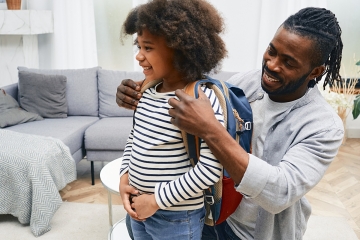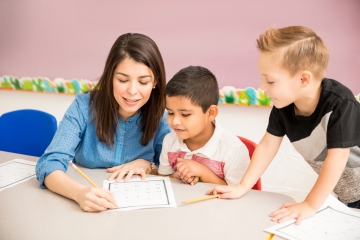Millions of Americans are quitting their jobs. “The Great Resignation” is causing a labor shortage in many industries, as workers leave for other jobs or simply stay home. The field of education is one that’s hurting. “No more teachers” Politico blares, perhaps overstating the case. NBC notes that 48 percent of surveyed administrators said their schools or districts were “having trouble finding enough full-time teachers.” Some other reports dig into the federal data on employment and don’t find the same catastrophe. Yet it’s clear that, after three disrupted school years in a row, many teachers feel like they’ve had enough.
I know firsthand. In December, I left the classroom after more than a decade. For the first time since I began my education career in 2009—first as a substitute teacher, then as a fulltime aide, and ultimately as a head teacher in kindergarten through second grade—my days are no longer paced by the tones of the school bell. Now I don’t lead morning meetings or teach reading strategies or decorate bulletin boards. I am no longer “Mr. Grossman” (or “Mr. G” if it’s early in the year and we’re still learning names).
Quitting was not an easy decision. No one leaves a career more than ten years in the making on a whim. But I knew I was suffering from that other malady that’s sweeping the nation: burnout. In a piece for the New Yorker last year, Jill Lepore wrote that, “To be burned out is to be used up, like a battery so depleted that it can’t be recharged.” Symptoms of “burnout syndrome” include “exhaustion, cynicism, and loss of efficacy.” Check, check, and check.
It’s not that I became disillusioned with teaching per se. I firmly believed, and still do, that a quality education is the moral right of every American child. I still believe that education is the most effective strategy available to us to lift people out of poverty and into the middle class. And I still believe that education is the best tool we have to promote human flourishing in a free and open society. What I stopped believing is that I could participate in this noble cause, day in and day out, while also maintaining my health, sanity, and personal relationships.
The most difficult part of teaching is not planning lessons, grading tests, or responding to misbehavior. These things take years to master, but they can be managed by most novice teachers. In time, I got pretty good at these duties and even came to enjoy doing them. When done in an intentional, systematic way, they allow students to grow and succeed. That’s rewarding to see, even when it’s a heavy lift.
It’s the emotional labor of being a teacher that burned me out. Teachers are not just responsible for the academic achievement of the two dozen young people in their classroom; they are also responsible for the emotional well-being of children. A teacher is only as good as the bond he or she forms with students. It is a connection that is built through patience, consistency, and an extra-large dose of empathy. It is especially true for the early elementary grades. Teaching kindergarten means juggling the roles of educator, life coach, surrogate parent, and unlicensed nurse.
This can be exhausting even when there’s not a once-in-a-century pandemic. During my tenure, I helped students manage countless routine conflicts and small disappointments—arguments over who gets to use the blue crayon first, the agony that comes with being excluded from a playground game, a test score that falls below what was expected. And that doesn’t even cover the extreme cases, such as the fistfights I broke up, the calls I made to Child Protective Services to report abuse by a parent, the thrown chairs I dodged.
The pandemic sent this emotional labor into overdrive. When schools first closed their doors in 2020, it was a shock. My school went to spring break a day early (“just to be safe”) and didn’t return to in-person instruction until fall. There was no time for an orderly transition, no time to prepare students for the seismic shift that was happening under their feet.
I’m thankful that my school had the resources to send each student home with an iPad so learning could continue remotely. But the digital space of our Zoom sessions did little to foster the community we had built in the classroom. Students who had been practically bursting at the seams during carpet time were now listless. This was understandable. I saw more than one child break down in tears, frustrated by the isolation and the uncertainty. As much as possible, I tried to create a safe space where my young pupils could grapple with their emotions. But at the same time, I was responsible for my own child, less than a year old and suddenly deprived of daycare. I became a multitasker, trying to make lunch while leading math lessons. My son learned to crawl during this stage of the pandemic, and more than once I had to excuse myself from a Zoom session because he was “exploring” the dog’s water bowl.
When I returned to in-person learning that fall, things improved, but not enough. Children that were thrilled to see their friends again were told to keep six feet away from them at all times, which meant no hugs, no high-fives, and very limited partner work. At one point, an administrator told faculty members not to stand next to children when helping them with school work. It was much safer to stand in front of them, separated by those six feet. And the cloth masks we forced students to wear robbed everyone of a whole range of non-verbal communication. Learning now that those masks weren’t effective infuriates me.
It killed me to enforce protocols that I knew were not developmentally appropriate for young children, but the consequences of not doing so could have been much worse. So literally dozens of times a day, I reminded students about maintaining proper social distance and not letting their masks slip below their noses. No one likes a nag, and a nagging teacher is even worse. After a while, the kids just stopped listening.
It was about this time when I knew something was wrong. I put my head down, gritted my teeth, and finished the school year. I thought summer break would be my salvation. I would recharge and come back strong in the fall. The faculty at my school had a vaccination rate around 90 percent, so the next school year would be a little closer to normal. Maybe we could even take off the masks! Then Delta hit and brought me back to reality. More distancing, more masking, more uncertainty.
My last school year as a teacher began in August 2021 and ended by winter break. I was done.
I now work from home and things are different. Some changes are welcome. Beginning work at 9 a.m. means I spend more time with my son. While teaching, I was usually out the door before he was even awake. When I stayed late for back-to-school nights or conferences, I might not see him at all that day. Being able to take a personal call during the day is also nice. And when Friday comes, I no longer pass out by 8 p.m. from sheer exhaustion.
Yet I miss it, too. Young kids are some of the funniest, most curious, most interesting people you’ll meet. Their capacity for joy is immeasurable. Want to see pure elation? Watch a group of kindergarteners on their way to recess when it’s snowing. It’s even better when you’ve commandeered some lunch trays for sleds (not that I would do that). It’s a paradox of teaching that students exhaust you but still infect you with their contagious energy. They love learning, so they make you love teaching.
But here’s the rub: The source of my burnout, which is the emotional labor of being a teacher, is an essential part of education. There’s no way to eliminate it from our schools, and we shouldn’t try. That makes dealing with the burnout an enormous challenge and complicates the resignations that it causes. The solutions on offer—higher pay, more flexible schedules, emotional sick days—aren’t bad ideas, but they don’t really get to the heart of the problem. Until we move past the pandemic, I’m not sure anything will.









